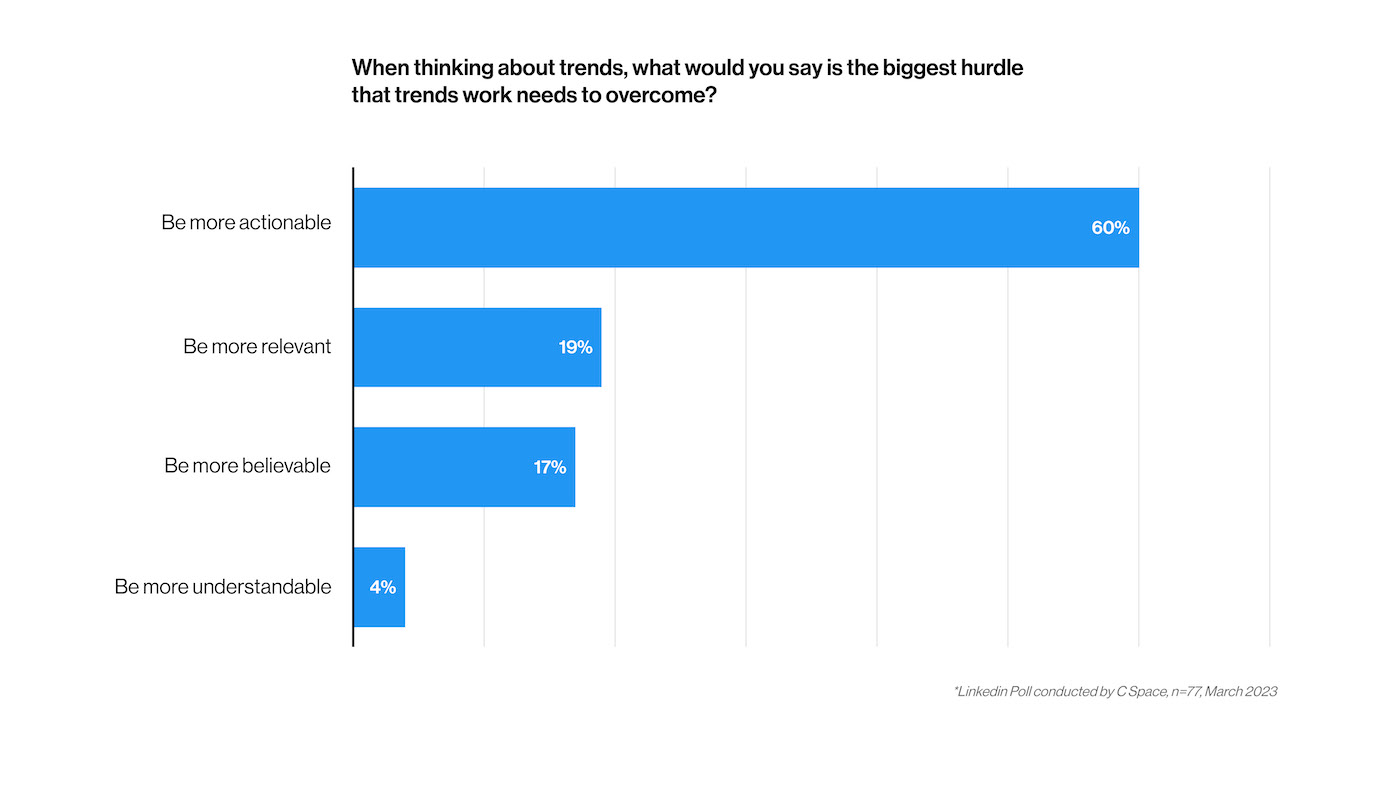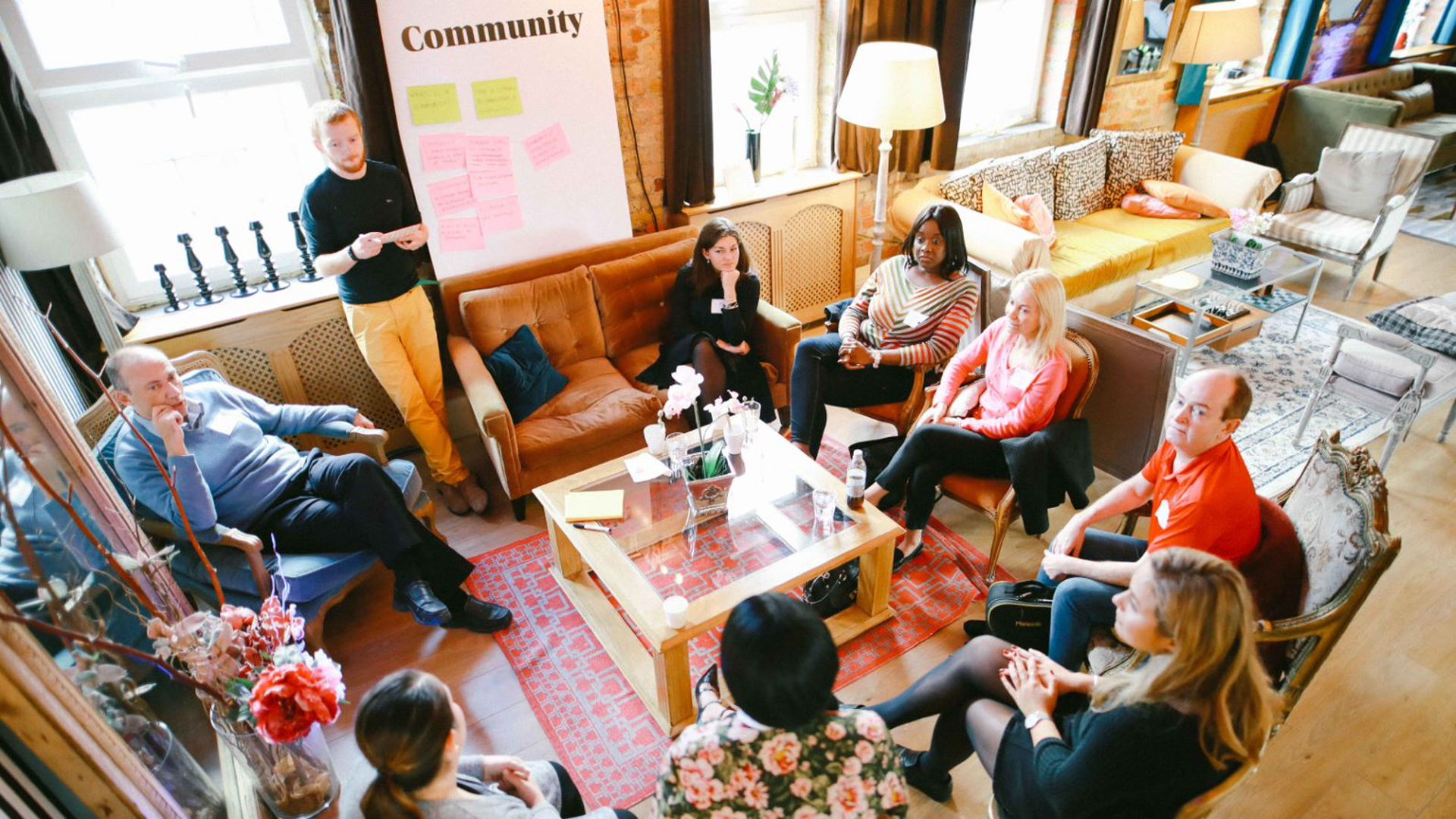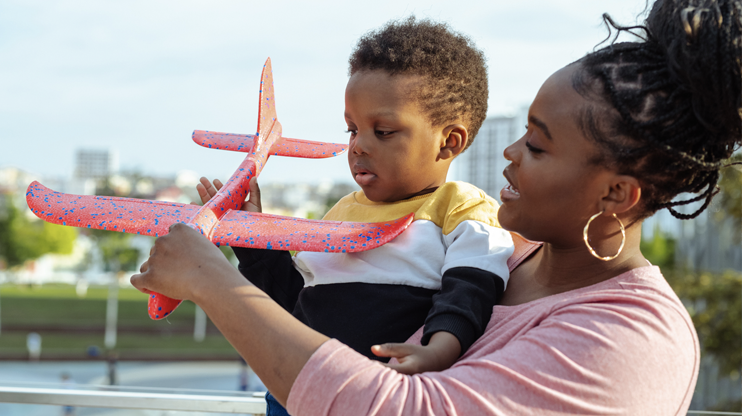WHITEPAPER SERIES
Foresight Principle 3
Get the business to care.
What’s the biggest challenge insight professionals face with Foresight work? It’s making Foresight impossible to ignore. It’s getting the business to care and act. Read on to discover how making Foresight real and human is more likely to drive action internally.
This is part three in a three-part series in which we argue that consumers are just as important as experts, trends and AI predictions in helping brands minimise risk in Foresight strategies. Scroll down to navigate to another part within the series.
Insight leaders’ biggest challenge and greatest focus isn’t getting to insight – it’s getting stakeholders to listen — and act.

Two thirds of participants in our LinkedIn poll cited actionability as the issue when grappling with trends and future strategies. By its nature, foresight can be vague, intangible, and out of reach. Listen to these quotes and weep…
The problem in a nutshell: foresight is easy to love, but even easier to ignore.
What’s often driving this is the fear of change. It’s just not in our make-up to lean into it: as the CEO of Panera Bread likes to say: “The only person who likes change is a wet baby.”
And yet, you can ignore a trend or two, and your top line won’t be much effected. But ignore foresight, and the damages will be irreversible — just ask Blockbuster.
For foresight strategies to be successful, they need to change what brands do, not simply what they know.
So how do you drive change? How do you make your business see the potential in your foresight so they act on it?
Here are a few lessons, from our 20+ years of trying.

Co-creation is a powerful, but not always well-understood approach. The academic literature is growing, but we’ve been doing it for decades. Many of our observations are summed up in the article ‘The meanings of co-creation’, co-authored by Global Consulting Director, Dr. Nick Coates (Coates and Ind, 2012).
Far from outsourcing ideas to customers, co-creation works by creating a more level, collaborative, playing field. We see co-creation as the active, creative, and social process of involving all those who have a stake in the outcome to shape better solutions together. Front-of-house and back-office staff. Seniors and juniors. Consumers and experts. Agency and clients.
Co-creation, in our experience, offers two significant advantages over black-box methods.
1. It generates buy-in: also known as “The IKEA Effect” (the idea that people attribute more value to products they’ve helped co-create, whether that’s adding an egg to a cake mix or dreaming up a new cruise experience), it’s crucial in overcoming the “not invented here” bias in business. In foresight projects, if people have a hand in “shaping” the direction, they’re much more invested in it. Where short-term priorities often take importance and long-term strategies are less measurable, belief building is that much harder. So run a mile from the ‘big reveal’ and discover together.
2. It gets to diverse thinking and braver ideas: mixing mindsets helps challenge deeply ingrained assumptions (no one will pay for flat beds in business) and enables people to think about problems through a different lens. This leads to better questions being asked, and ultimately more complete solutions. Our “trajectory” approach (outlined in principle 1) is an inherently co-creative process.
So, co-creation and collaboration are essential to landing foresight. It’s not about more meetings with more people, it’s about better conversations, fuelled by cognitive diversity and collective epiphanies.
A few tips and tricks to help build a co-creative foresight approach:
Collaborate
Spending less time together in a room engaged in messy play, and more time in front of a webcam, is a massive risk in the diverge-converge process that’s essential to structured collaboration. So flex your Miro muscles and get fluent in virtual co-creation. We’re increasingly wondering why you wouldn’t. These spaces shift the way we work:
o From complexity (spinning around the wrong problems) to clarity (visualising & triangulating to better define the problems to solve)
o From fragmentation (multiple inputs in multiple places) to fusion (bringing all the best inputs together in a single, universally visible, space)
o From individualism (siloed thinking and misaligned implications) to shared understanding (asynchronous, virtual, and collaborative sense-making)
o From exclusivity (extrovert interaction for loudmouths and power mongers) to inclusivity (creative and collaborative thinking that maximises collective intelligence)

Stakeholders are busy, and it’s often hard to get their attention and commitment. So instead of big calendar blocks or opt-in/opt-out meetings, creating physical (or virtual) project spaces helps raise visibility, provide a destination for thinking, and, crucially, make stakeholders feel they’re influencing the outcome (“they’re asking my questions, so it’s more useful”).
Often the highlight of any co-creation process, large groups – like our flagship Big Talk sessions – bring together stakeholders, consumers, and experts to shape the future. They require precision planning, expert facilitation, and an experimental mindset, but done well, they’ll create an embodied experience that lives long in the memory. Time and again, clients tell us things like “This was the best day of my entire career”. For Nissan, we crafted a day of theatre, improv, and dreaming (plus an interactive Alexa experiment) to help engineers glimpse the future of driving in 2035 through customers’ eyes. Our most senior client told us this immersive approach helped them re-learn how to do foresight.
Activate trajectories by bringing focus and getting commitment:
As Ned Colville (Interbrand’s Global Human Truths Director) likes to remind us “coming up with ideas is easy. Picking the right one is the hard bit”. Roadmapping helps get us there with confidence.
Future strategies need to get real quickly or they wither on the vine. Whether it’s a re-positioning, a comms refresh, or a new product, service, or experience, prioritising is critical. Collaborative filtering against organisational frameworks and imperatives can help strategic alignment. For example, does it address our sustainability agenda? Does it piggyback on a strategic technology investment? Does a new partnership unlock possibilities?
Depending on where you land, this means either aligning on baby steps towards a future vision or building the organisation’s capability to respond and adapt to changing realities. Road mapping generates collective commitment for doers in the business, helping them build confidence and control for what comes next.

“Maybe stories are just data with a soul.” – Brené Brown.
We live in an age of distraction and short-term priorities. If you want your organisation to pay attention and act, it’s crucial to help stakeholders feel what tomorrow could bring and grasp the opportunity beyond the inevitable hard work.
Like consumers, stakeholders are stuck in their own biases and need nudges (stimulus, stories, provocations) to think into their futures. We find that humanising the work through stories makes future worlds stick. They help stakeholders connect the head and the heart – to move beyond rational objections. They also move foresight work from ‘fluffy’ and ‘inspirational’ towards more tangible outcomes; they engage the limbic brain that drives the impulse to action.
But how to achieve this?
Help them see, feel, hear & touch (and even smell) the near and next. Adopting a sensory campaign mindset (branding the project, drip-feeding nuggets, painting a picture…) creates visceral anticipation and buzz from the outset. It makes people want to turn up to meetings, come with contributions, and feel compelled to lean in and act.

o Nudge with newsletters: made up of raw insights, killer quotes, images, and video from conversations around the world, it’s an irresistible package that’s fun to read and builds excitement for what’s next.
o Play with podcasts: bite-sized, brain-friendly, audio content on key topics and themes, they fit into modern mobile lifestyles and worm their way into ears and minds.
When your client tells you they shed a little tear hearing how technology makes an ex-CMO with arthritis feel less lonely and part of their grandchildren’s lives, you know you’re onto something.
o Future documentaries: forget corporate videos, stock footage, cheesy soundtracks and 1990s animation, documentary formats are today’s must-have content. They’re insight stories elevated by filmmaking craft for the age of Netflix. Think single, longer, films, like our recent Dwell: Experiments in Living mini-film, or Up Close: our Gen Z mini-series for McDonald’s. Human storytelling transports people away from day-to-day concerns into future worlds.
o Guided fantasy: meditation is a fantastic tool to help people manifest and energise a big debrief. While it might take a healthy dose of courage from you and a bit of a leap of faith for your audience – we promise it’ll bring the whole crew into the topic and the right mindset.
o Immersive spaces: sure, it may not always come cheap, but real-world experiences pay dividends. Try hacking your client’s canteen, taking over unused meeting rooms, and turning them into a “future gallery”, like we did for Bose to create a premium activation for their future segments, or for McCormick to bring flavour trends to life. It’s much harder to ignore something you pass through every day.
Per Confucius (and a million other people judging by the internet) “Tell me and I’ll forget, show me and I may remember, let me experience and I’ll believe”. Doing is how we learn. It’s what makes it real.
o Give them a voice: we always have stakeholders join in, get up close and dirty, come on road trips, visit people’s homes, and live the research. But if you can’t (life’s busy after all), why not bring people to them? You can do it remotely – as our recent CX therapy sessions for Bupa proved. But don’t leave it to chance – it takes auditioning, preparation, a safe space for curiosity, and empathetic listening. And it lands when you bring in early adopters and under-represented communities. An inclusive approach breeds more inclusive open-minded thinking.
o Glimpses of the future: never been in a Gen A footie Discord? Never donned a VR headset? Never flexed your Midjourney muscles? Just give it a go, in a safe space. It’s a great opportunity to get inspired by other categories, other brands, and even better, other cultures.

o Immersive theatre: if your team is struggling to ‘get’ the benefits of autonomous vehicles, why not try working with devised theatre & improv groups to stage future narratives that are fully immersive? Our Act Don’t Act events put stakeholders right into the middle of the action, in a 3D space with actors and an AI car character where they got to debate and shape the unfolding narrative. Choose your own adventure is a powerful format, still.

To cut through the noise and create direction and future principles that last far longer than isolated concepts, we focus on the dynamic DNA for future decisions. Moving from ‘tells’ to tools fuels durable and pragmatic organisational impact:
- Frameworks for re-imagining what they do, not simply what they know.
- The right questions to ask that will last years not days.
- Dynamic guidelines for thinking and decision-making.
As J. Peter Scoblic, co-founder of Event Horizon Strategies, puts it: “If companies want to make effective strategy in the face of uncertainty, they need to set up a process of constant exploration—one that allows top managers to build permanent, but flexible bridges between their actions in the present and their thinking about the future. What’s necessary, in short, is not just imagination but the institutionalisation of imagination.” ( HBR)
Our favourite, best-performing tools include:
Forward-moving springboards that are anchored in drivers and shifts, and enriched with behavioural signals, semiotic insight, and brand moves to inspire action.
Instead of static and wordy reports, these are highly directional guidebooks that help cross-functional teams think differently about their challenges.
Beyond overwhelming data dashboards, we love interactive digital resources that allow internal teams to explore and ideate on demand.
Together this can become a powerful cocktail for change.
Shape your future and lead.
“If you are unwilling to disrupt your business, there will always be someone willing to do it for you”, said Netflix’s Mark Randolph. Seeing round corners is indeed the name of the game, but disruption doesn’t sound like much fun for humans caught in the swirl of high-pressure business culture.
The last few years have been an exciting and daunting time for futures professionals. Technological breakthroughs – from generative AI to datafication and blockchain — are paradoxically and perversely landing against a backdrop of conflict, recession, and crisis.
So while the future can feel like a scary place, we believe brands can take a leading role by getting ahead of change, to be better placed strategically and future-proof themselves. But only if we can be more proactive customer agents and resist the impulse to react more than we act.
So as you find yourself drowning in the day-to-day, remember…
It’s not all or nothing:
Brands don’t need to panic and blindly engage with every signal / emerging trend. For brands, we need to be more intentional: learn where to lead the conversation, and where simply be part of it.
Adopt a more active role:
Don’t simply ask: what are the ‘implications’ of a trend, but rather, how can we steer the business in a positive direction? That’s why our approach starts with a ‘yes, and’ mindset; reframing challenges as possibilities. Moving beyond expectations for the category.
Embrace the Relationship Economy:
In an era defined by globalization, disruption & digitization, where customers have more choices, and demand more agency, we see the emergence of a new phase in business: the Relationship Economy. In this new world, “the biggest shifts are driven by what people expect of brands… and the fastest growing brands are relationship-obsessed.” (Research Live).
In the foresight world, this doesn’t just mean showing up where it matters to customers and optimizing individual interactions. That’s clearly valuable, but there’s more. Relationship Thinking teaches us to take a more holistic, reciprocal view of the role we play. It’s based on asking different, relationship-oriented, questions:
- who will you really be ‘for’ in the future and what matters most, to them?
- where, in their lives, are the jobs that you can credibly tackle for mutual value?
- what’s the right way to deliver this new value exchange, given your talents?
- how will you organize around these relationships, emotionally and functionally?
As insight professionals, we should already be well placed to bring more humanity to futures work, but in this new Relationship Economy, we finally have the business imperative to make the case for proactively investing in customer relationships. And Foresight, we think, is going to be the critical asset for getting us there, together.
Introducing our 3 Foresight principles.

PRINCIPLE 1
Create trajectories, not only destinationss
How do we move from crystal-ball gazing to building an intuitive muscle for what’s next? We’ll show how using trajectories to work backwards can help you avoid costly mistakes.

PRINCIPLE 2
Focus on what’s not changing
How do you avoid backing the wrong future strategies? We’ll argue that running consumer experiments can bridge the gap between today and 10 years from now.
FORESIGHT
THE FORESIGHT TOOLKIT
Your ultimate companion for seamless foresight work.

Unlock the key to foresight success with our comprehensive toolkit! By downloading our poster guide and complete whitepaper, you’ll gain access to invaluable insights and practical guidance.
This toolkit not only provides an easy and digestible understanding of foresight, but it’s also the perfect resource to assist with foresight brief creation and study design for any insight function. Whether you’re penning a concise brief or crafting a captivating study, our fool proof 3 principles will lead you to success.
Don’t miss out on this opportunity to supercharge your foresight journey. Download your toolkit now and embark on a path of foresight excellence!



